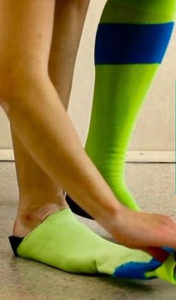Previously, we've shared posts about the great reasons to start wearing compression socks. To recap: they could help protect you from deep vein thrombosis, or DVT. Plus, they can slow the progression of vein disease. Moreover, they can reduce swelling and fatigue; boost your circulation; enhance your athletic performance; and can help you manage chronic conditions such as varicose veins. Plus today, more than ever, they come in lots of cute styles! So now that you have the "why" when it comes to compression stockings, we'd like to address the "how." After all, it can sometimes be tricky to work these tightly-fitted compression socks onto your legs. But first, let's examine 5 early warning signs of deep vein thrombosis.
Wearing compression socks can help prevent DVT. Here are the signs to look for, that can tell you you're in danger for deep vein thrombosis.
Got any of these symptoms? We may recommend compression therapy. And, if that's the case, you'll need to know the right way to put on compression socks. So we hope this guide can help ease this somewhat complex process.
First of all, it's important to remember that compression stockings aren't like typical pantyhose. So forget the usual

Creating a pocket for your toes is the first step to properly applying compression stockings.
ways you pull on stockings. Before putting on compression stockings, you should take off any jewelry and dry your legs completely. Now you're ready to begin application.
Step 1: Whatever you do, don't bunch up the feet of your stockings. This would only concentrate all that pressure in one small area, making it harder to pull your stockings into place. Instead, reach your hand down and through your stocking, and grab hold of the heel. Keep hold of the heel and turn your stocking inside out. This will create a little pocket for your foot!
Step 2: Put your toes in the foot pocket you just created. Pull the stocking up to your heel, then grasp the top layer of fabric, right near the middle of your foot.
Step 3: Keeping hold of the fabric, lift the stocking over your heel and pull upwards until your heel is completely covered.
Step 4: Now, use both hands to grasp the remaining loose fabric. Pull it gently up over your calf. Going slowly, continue sliding the stocking upwards, until it rests over your knee. Smooth any wrinkles, making sure the stockings are laying properly in place.
Step 5: Repeat on other side, then get dressed and go. You're ready to start your day with a valuable tool to support your vein health!
Remember, compression socks come in different levels of intensity. And it's important to wear your socks as prescribed. Otherwise, your socks may be too tight for your needs, negating their potential benefits. But how can you tell if your compression socks are too tight? Here's what to look for:
If you notice any of these warning signs, talk to us about the fit of your compression socks before putting them back on. And, take note of these moments when you should avoid wearing your compression gear, regardless of their fit.
Now, compression socks are important medical devices. By wearing them all day, you can boost blood flow, prevent restless leg syndrome, and improve your sleep by up to 82%, according to this study. As such, you might think that wearing them day and night would be the best way to support your vein health. But, in fact, that's not the case.
You see, there is a time when we want you to take off your compression socks. And that time is at night, when you're sleeping. Here's why: if you sleep in these garments, you could interfere with your body's ability to regulate blood flow. In fact, you could even restrict circulation, the exact opposite of what you're hoping to do!
Also, wearing compression hose at night can compress or irritate your nerves. In turn, you could experience burning pain, tingling or loss of sensation in your legs. Finally, by staying in your gear all night long, you're more likely to irritate your skin. Or, you may disrupt your sleep. And that could interfere with your vein health since experts say you need a certain amount of rest to keep your blood flowing properly.
Now that you know how to get into these items of clothing (and when to take them off), we need to be sure you pick the perfect pair for your needs. After all, medical compression socks actually require a prescription to make sure you get the right amount of pressure, so you can't just go online and order a pair that looks pretty. Instead, our Houston and Dallas area vein specialists are here to help you find the right pair to protect your circulation and prevent dangerous clots. So schedule an appointmentschedule an appointmentschedule an appointment at one of our Houston and Dallas area clinics today!

Scheduling
Please contact our dedicated specialists to schedule a consultation today.
2024 Texas Endovascular. All rights reserved. Website Design by Healthcare Success